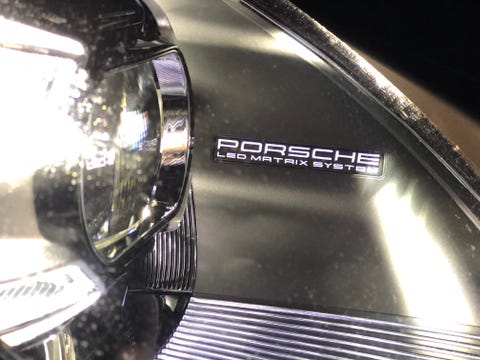I didn’t figure I’d fall in love with the 2021 Porsche 911 Turbo S for its headlights. This, after all, is a car that has 640 horsepower, does zero-to-60 in 2.6 seconds and tops out at 205 mph. I figured I’d be into it for mostly those reasons, which are pretty solid positives in any context. But this particular Turbo S wore a German plate up front and carried a German registration decal on the windshield. These days, there isn’t usually much difference between a US-market car and one destined for Europe, but the European Turbo S includes a major feature forbidden to us here: LED Matrix headlights. Now I’m totally ruined for our dumb old lamps, for I have literally seen the light. And we can’t have it.
Each of the 911’s lighting units includes 84 individually controlled LEDs that allow the car to continuously morph the pattern of its beams. When a car approaches in the oncoming lane, the 911’s headlights dim around it while leaving the rest of the pattern bright. The other driver doesn’t get blinded, but you still have blazing lights on your side. It’s a wonder to behold. During nighttime drives in the Turbo S, I never had another driver flick their high beams at me in annoyance—which sometimes happens with cars that simply have bright LED low beams. The Porsche would also dim the right side if road signs on the shoulder were overly reflective. Sometimes, you’d see the lights go through two distinct dimming phases, which illustrates how blazingly bright they are at max wattage. With all 168 LEDs at full blaze, you feel like you can see a quarter-mile down the road. And maybe you can.
Porsche’s adaptive lights are clearly a major improvement over the simple high-beam or low-beam setup mandated for the U.S. So why can you get them in Munich but not Milwaukee? At issue is Federal Motor Vehicle Safety Standard No. 108., which has defined our headlights since 1967. And ol’ FMVSS 108 set out rules that only defined high beams and low beams, because back then we didn’t have Willy Wonka headlights that can go sideways, and slantways, and longways, and backways.
History buffs will note that 1967 was a long time ago and since then a few things have changed in the realm of vehicular forward roadway illumination. But the rule remains in place for the simple reason that it’s really hard to get everyone involved to agree on what should come next. There is hope, however. Toyota has petitioned NHTSA to change the rule, allowing adaptive headlight systems. And it looked like that process was grinding forward in 2018, when it was in the phase where manufacturers could weigh in with comments (Subaru pointed out that NHTSA referred to a “potion” of a test when it meant “portion” and we respect their attention to detail-slash-pettiness.) But, big surprise, no updated rule has been finalized. And that’s why we’re still stuck with high beams and low beams and no in-between beams.
This content is imported from YouTube. You may be able to find the same content in another format, or you may be able to find more information, at their web site.
I have a solution to fast-track approval of the new rule. It involves dropping a certain 911 Turbo S at NHTSA for a week or two for, you know, measurements and whatnot. Be the change you want to see in the world, Porsche. And maybe after the headlight thing is squared away, we can talk to them about my idea for the Autobahn Lane.
This content is created and maintained by a third party, and imported onto this page to help users provide their email addresses. You may be able to find more information about this and similar content at piano.io


